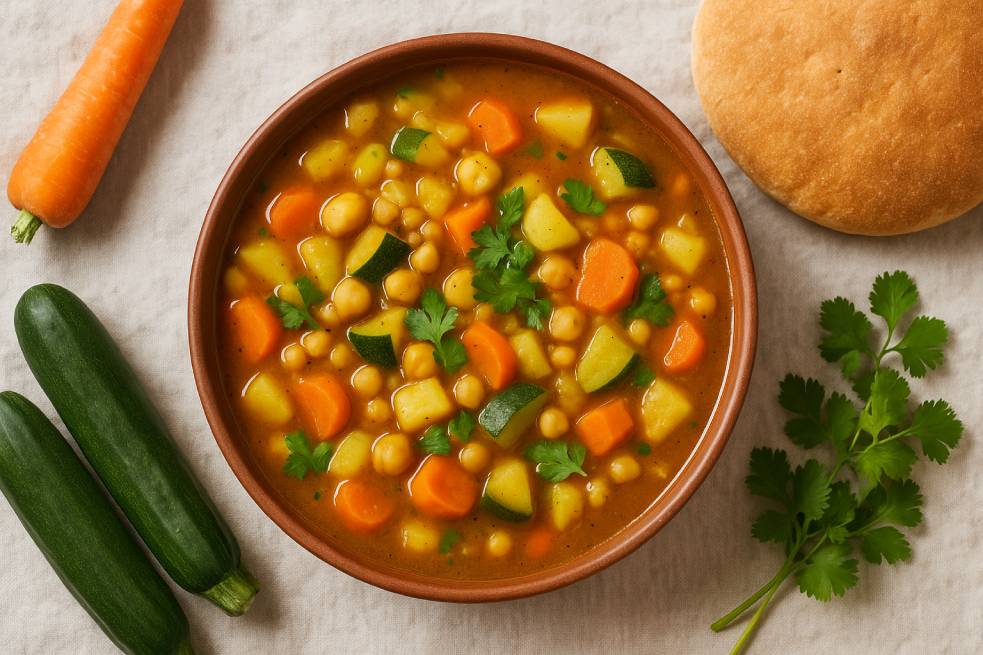🍲 Introduction
Table of Contents
Moroccan Vegetable Soup is a hearty and flavorful dish rooted in centuries of North African culinary tradition. Known for its comforting texture and warming blend of spices like cumin, turmeric, and cinnamon, this soup is a staple in Moroccan homes, especially during colder months and the holy month of Ramadan.
Unlike Western vegetable soups, the Moroccan version combines seasonal vegetables, legumes like lentils or chickpeas, and bold aromatics to create a nutrient-dense, satisfying meal. It’s naturally vegan, highly adaptable, and full of anti-inflammatory ingredients aligned with the Mediterranean diet, praised for its health benefits.
Whether exploring global flavors or searching for a nutritious, plant-based recipe to add to your weekly rotation, this Moroccan Spiced Vegetable Soup delivers comfort, culture, and wellness—all in one bowl.
🥄 What Is Moroccan Vegetable Soup?
Moroccan Vegetable Soup is more than just a nourishing meal—it’s a culinary representation of Morocco’s deep-rooted food culture, where simplicity meets flavor, and every bowl tells a story of tradition, resourcefulness, and spice.
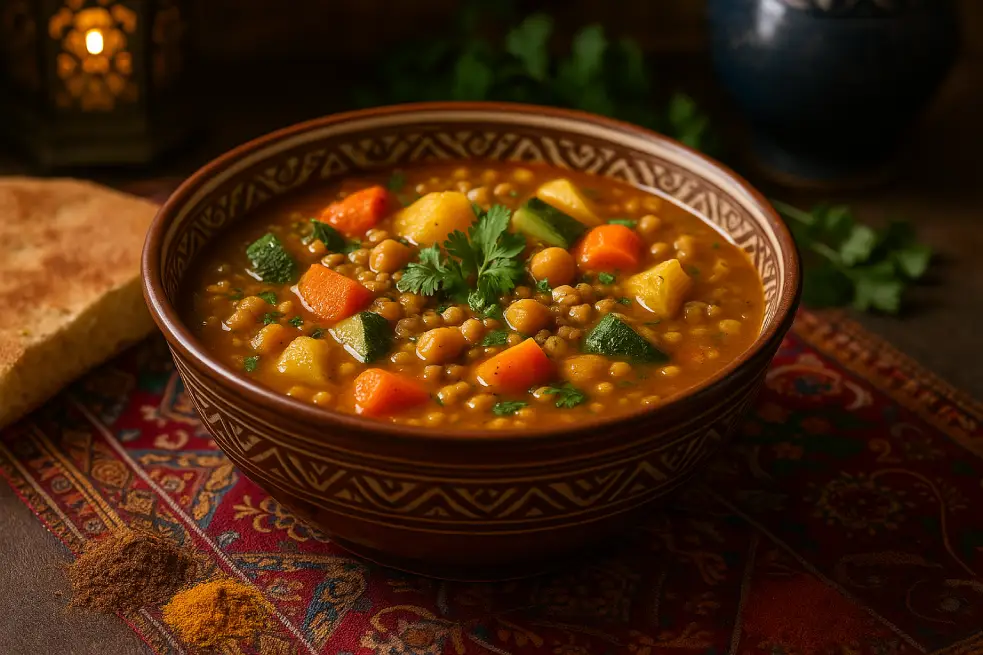
🌍 A Heritage of Flavors
In Moroccan households, soup is not merely an appetizer—it is often the centerpiece of a wholesome meal, especially during winter months or religious occasions like Ramadan. While the more famous Harira dominates the spotlight during Iftar, the lesser-known but equally satisfying vegetable-based soups offer a lighter, healthier alternative with the same warming soul.
Unlike typical Western-style soups that may rely heavily on cream or broths, Moroccan Vegetable Soup is known for its spiced broth, often created by blooming spices in olive oil—an essential technique in Moroccan cuisine. Ingredients like turmeric, cumin, paprika, cinnamon, coriander, and ginger are gently cooked to release their aromatic oils before being combined with chopped vegetables and legumes like lentils or chickpeas.
The result is a thick, hearty soup that warms the body, satisfies the soul, and nourishes with layers of flavor.
🥕 A Celebration of Seasonal Ingredients
What makes Moroccan Vegetable Soup special is how easily it adapts to what’s in season or already in your kitchen. Traditionally, families use what’s in season—turnips in winter, zucchini in spring, tomatoes in summer—resulting in countless variations of this humble dish. Potatoes, carrots, celery, onion, garlic, and fresh herbs like cilantro and parsley are almost always present, creating a base of depth and nutrition.
In rural regions, home cooks often add dry lentils, barley, or broken vermicelli noodles (chaariya) to make the soup more filling. Olive oil, a key ingredient in Moroccan cooking, enriches the soup with flavor and nutritional value, firmly placing it within the heart of the Mediterranean way of eating.
If you’re curious about Moroccan culinary balance, explore how this soup fits within a typical Moroccan meal like Rfissa, where spices, grains, and herbs work together in harmony.
✨ More Than a Recipe—A Ritual
In Morocco, preparing soup is a ritual. Elders pass down the ritual of preparing vegetables, guiding young hands to work in tune with the daily pace of Moroccan life. The aroma of simmering soup often signals warmth, welcome, and wellness. It’s common to find this soup served with Moroccan bread, such as khobz or batbout, or even paired with simple salads like zaalouk or taktouka.
This dish also reflects Moroccan values of hospitality and zero waste. It embraces the concept of using available ingredients and turning them into something comforting and delicious—no fancy gadgets or exotic imports are required.
💡 Pro Tip:
Authenticity doesn’t mean rigidity. Moroccan Vegetable Soup is deeply personal. Add rice, skip potatoes, throw in some cabbage—it’s all still “Moroccan” as long as the spices guide your hand.
🥕 Essential Ingredients for Moroccan Vegetable Soup
Moroccan Vegetable Soup is a celebration of color, aroma, and flavor, brought to life through an intentional blend of seasonal vegetables, bold spices, and fragrant herbs. Each ingredient transforms a simple broth into a rich, soul-warming experience. Let’s explore the foundational elements that define this dish.
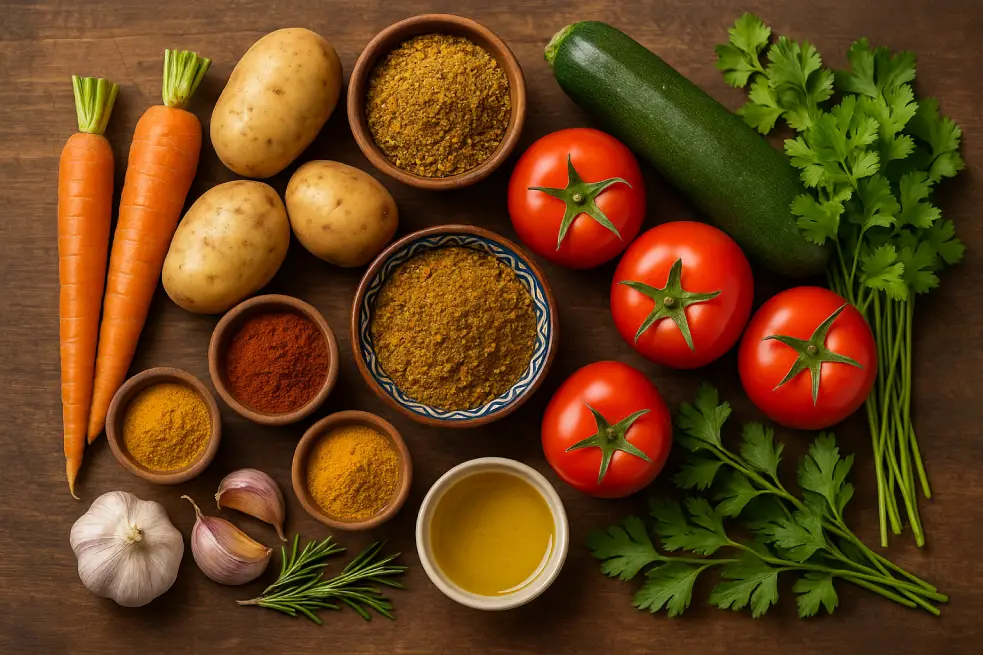
🥦 Core Vegetables: Carrots, Potatoes, Zucchini, Tomatoes
The vegetable base of Moroccan soup reflects the country’s commitment to wholesome, local produce. Carrots bring natural sweetness and color, while potatoes offer a creamy texture and body. Zucchini adds freshness and lightness, balancing the denser ingredients. Whether fresh or in paste form, tomatoes infuse a subtle acidity that lifts the entire flavor profile.
In Moroccan households, these vegetables are often diced finely or grated, allowing them to melt seamlessly into the broth. The result? A hearty and silky soup—a perfect blend of texture and taste.
What makes these ingredients even more special is their accessibility. These staples are found in nearly every Moroccan kitchen and symbolize a diet rooted in nutrition and economy.
🌶️ Signature Moroccan Spices: Cumin, Turmeric, Paprika, Ras El Hanout
Spices are the backbone of Moroccan cuisine and are not used sparingly in this soup. Cumin provides warmth and a slightly smoky undertone, turmeric gives a golden hue and earthy depth, paprika adds a mild kick and color, and the all-important Ras El Hanout brings an aromatic complexity unmistakably Moroccan.
Ras El Hanout, meaning “head of the shop,” is a spice blend composed of 10 to 30 different spices, varying by region and vendor. Some blends include cardamom, clove, cinnamon, coriander, nutmeg, mace, and dried rose petals. It’s considered the crown jewel of Moroccan seasoning and is essential for adding depth to vegetable-based dishes.
👉 Learn more about Ras El Hanout and its rich history on The Spruce Eats
📌 You can also see how it’s used in our Chicken Tagine with Prunes and Cinnamon recipe for a deeper flavor profile.
Each spice in the mix adds more than flavor—it brings a piece of history. Moroccan spice culture is a legacy of trade routes, regional diversity, and culinary storytelling passed down through generations.
🧄 Flavor Enhancers: Olive Oil, Garlic, Cilantro, Parsley, Saffron
Moroccan Vegetable Soup would fall flat without its aromatic foundation. Extra virgin olive oil, used generously, is not just a cooking fat—it’s a cornerstone of Mediterranean wellness. The oil is typically used at the beginning to sauté garlic and onions, infusing the base with boldness from the start.
Garlic sharpens the broth, while fresh cilantro and parsley add green vibrancy and a clean herbal note toward the end of cooking. If available, a few threads of saffron elevate the soup with subtle floral warmth and golden richness. Though saffron is optional due to its cost, even a pinch can transform the entire pot into something unforgettable.
In Morocco, these flavor builders are more than ingredients—they represent the balance between tradition and intuition in cooking. No measurements are written down, but generations of cooks know precisely how much to use by scent, color, and feel.
🥣 Optional Add-Ins: Chickpeas, Lentils, Lemon Juice
Additional ingredients may be introduced for variety or nutrition, depending on the occasion or household. Chickpeas and lentils provide protein and fiber, making the soup a complete meal. These legumes are common in Moroccan Harira and are just as welcome in a vegetable version.
Fresh lemon juice, added just before serving, brightens the soup and ties all flavors together. Some Moroccan cooks also zest the lemon peel for added depth. This final acidic touch is beneficial when the soup includes legumes, as it balances their richness.
🥄 Step-by-Step Preparation Guide
Making a flavorful Moroccan vegetable soup isn’t just about tossing ingredients into a pot — it’s a calming ritual, often passed down through generations. The rhythm of chopping, the aroma of spices hitting hot oil, the slow simmer that fills the house — these small moments turn a humble soup into something special.
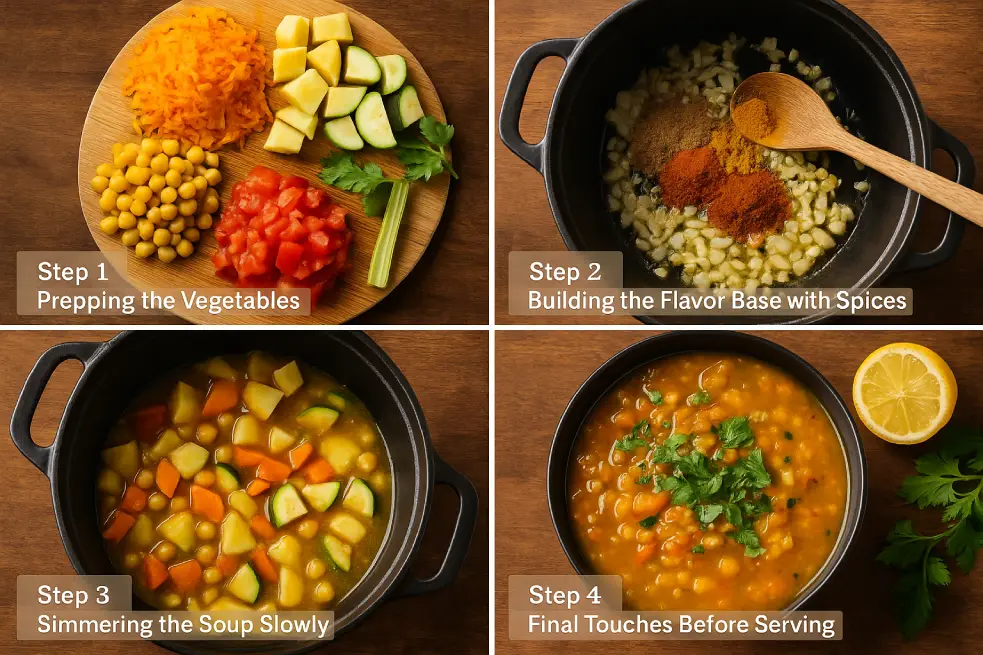
Whether cooking for a quiet weeknight or preparing a nourishing meal for guests, here’s how to bring this classic North African comfort dish to life, step by step.
🥕 Step 1: Prepping the Vegetables
A delicious Moroccan vegetable soup always starts with colorful, fresh ingredients. Choosing locally available produce at its peak guarantees better taste and a more satisfying texture. In many Moroccan kitchens, common choices include:
- 2 carrots (peeled and grated or finely chopped)
- 2 medium potatoes (diced)
- 1 zucchini (sliced or cubed)
- 1 yellow onion (chopped)
- 2 juicy tomatoes (preferably peeled and finely diced, or substitute with a tablespoon of tomato paste)
- 1 stalk celery (optional, for added aroma)
✨ Pro tip: Grating carrots and finely dicing onions allows them to melt into the broth, giving your soup a velvety consistency without the need for blending.
Some households also add a handful of chickpeas or red lentils at this stage to boost the protein and heartiness, especially during colder months or Ramadan.
🌶️ Step 2: Creating a Rich Flavor Foundation with Moroccan Spices
Spices are the soul of this dish. They don’t just add heat or color — they carry stories, trade routes, and generations of flavor. Start by warming 3 tablespoons of high-quality olive oil in a deep cooking pot over medium heat.
Then add:
- The chopped onion
- 2 cloves of garlic, minced
- A pinch of salt
Sauté for about 5 minutes, stirring until fragrant.
Now it’s time to bloom the spices — this step is crucial in any Moroccan-style soup:
- 1 tsp cumin
- ½ tsp turmeric
- ½ tsp sweet paprika
- ¼ tsp ground ginger
- Optional: ½ tsp ras el hanout for a more complex spice profile
Allow the spices to bloom in the hot oil for a minute or two, stirring to prevent burning and release their full aroma. You’ll know it’s ready when your kitchen smells like a spice market in Marrakech.
If you’re curious about how spices evolve through Moroccan cooking, this guide to ras el hanout breaks down its components and uses beautifully.
🍲 Step 3: Simmering the Soup Slowly
Add your chopped vegetables to the pot and stir to coat them evenly in the spice-infused oil. Then pour in:
- About 5 cups (1.2 L) of vegetable broth or hot water
You may also stir in ½ cups of cooked chickpeas or a handful of red lentils here. Let the mixture come to a soft boil, then turn down the heat and cover. Allow the soup to simmer gently for about 40 minutes, until the vegetables have softened completely.
This slow simmering is what gives Moroccan vegetable soup its depth. No shortcuts here — let the flavors mingle and mature with time.
If you’re interested in similar comforting dishes with deep-simmered flavors, try this hearty beef and green beans tagine that follows the same slow-cooking philosophy.
🍋 Step 4: Final Touches Before Serving
Give the soup a final taste before serving, and tweak the seasoning to your preference:
- A handful of chopped fresh cilantro and/or flat-leaf parsley
- A generous squeeze of fresh lemon juice (adjust the amount to suit your taste)
These finishing touches brighten the dish, balancing the earthy spices and bringing freshness to every spoonful. Some Moroccan cooks even add a bit of lemon zest for a more aromatic finish.
Optional: For a thicker texture, use an immersion blender to partially blend the soup — just a few pulses to retain some chunks while making it creamier.
Bonus tip 📝: This Moroccan vegetable soup stores beautifully. Let it cool completely, then refrigerate for up to 4 days or freeze in portions. Letting the soup rest overnight enhances its depth — many say it tastes even better the next day.
This breakdown on Serious Eats is worth bookmarking for a professional take on how layering flavors during simmering can elevate your soup game.
🍞 How to Serve and Pair Moroccan Vegetable Soup
Serving Moroccan vegetable soup is more than just ladling it into a bowl — it’s about creating a wholesome, balanced experience that reflects the warm hospitality of Moroccan culture. Whether you’re sharing this soup with family on a cool evening or offering it as a comforting appetizer, the right accompaniments elevate flavor and atmosphere. Here’s how to serve it like a Moroccan, with thoughtful pairings that enhance the meal from start to finish.
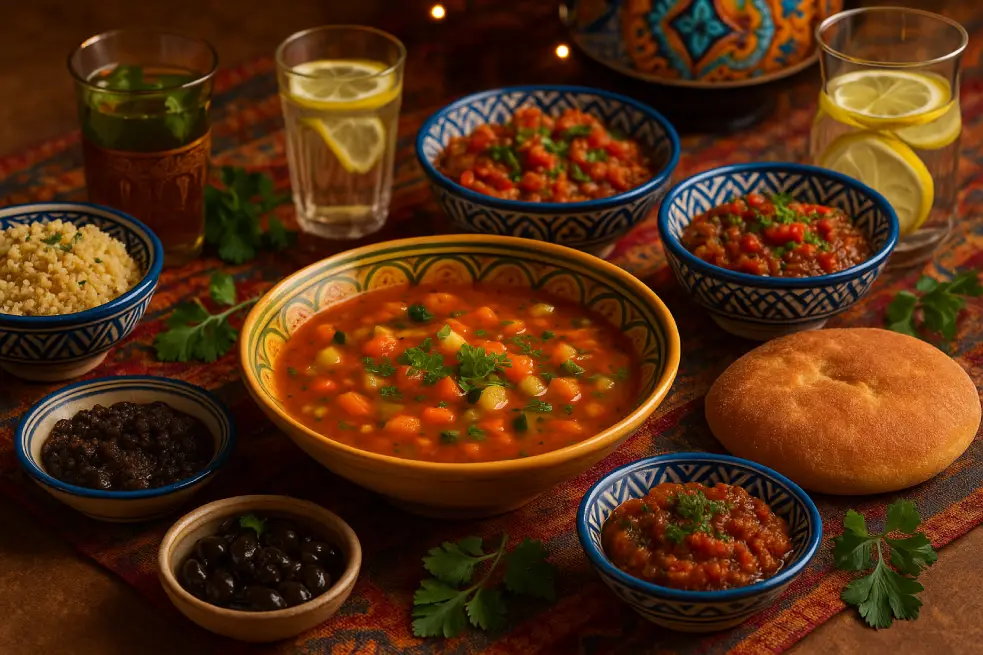
🫓 Traditional Accompaniments: Khobz & Olive Tapenade
No Moroccan soup is complete without a good piece of bread, and khobz — a rustic, round, crusty loaf — is the gold standard. This bread is perfect for dipping, scooping, and soaking up every drop of the spiced broth. Its hearty texture holds up well even in hot soup, making it an essential companion to the dish.
Also, serve a small plate of olive tapenade or marinated olives on the side. Their briny richness provides a bold contrast to the gentle, earthy tones of the Moroccan vegetable soup. These small touches transform a simple bowl into a truly satisfying meal.
🍽️ Ideal Side Dishes: Couscous, Zaalouk & Taktouka
Looking to make this soup a more complete lunch or dinner? Serve it with a warm steamed couscous dish lightly seasoned with olive oil and a pinch of cinnamon or cumin. Light and fluffy couscous makes the meal more filling while letting the spices in the Moroccan vegetable soup shine.
For something cooler and more refreshing, Moroccan vegetable-based salads are ideal. Among the classic sides, you’ll often find zaalouk — a silky eggplant and tomato blend — and taktouka, known for its rich, smoky flavor from roasted peppers and tomatoes. Their bold, smoky flavors contrast beautifully with the gentle warmth of the soup.
👉 For a traditional Moroccan salad pairing, check out our recipe for Taktouka — it’s simple to prepare and makes a vibrant side.
These combinations aren’t just tasty — they reflect Morocco’s deep-rooted culinary philosophy of balance: cooked and raw, spicy and mild, warm and cool.
🍵 Beverage Pairings: Moroccan Mint Tea & Lemon Water
When it comes to drinks, you can’t go wrong with fresh lemon water to cleanse the palate or traditional Moroccan mint tea to complement the meal with a touch of sweetness and herbal depth.
In Morocco, serving mint tea goes beyond refreshment — it’s a welcoming ritual that symbolizes hospitality and connection.. Often served in ornate glasses and poured with flair, it brings warmth and welcome to any table. The subtle bitterness of green tea combined with fresh mint and sugar pairs harmoniously with the spices in the soup.
👉 Want to try brewing traditional Moroccan tea at home? This mint tea guide from NYT Cooking walks you through it.
🍂 Seasonal Variations & Serving Ideas
This comforting Moroccan vegetable soup adapts beautifully to the seasons, making it a delicious option on chilly evenings or warm spring days.
In colder months, serve it hot with added chickpeas or lentils for extra comfort. In warmer weather, lighten it by reducing the potatoes and serving it with a splash of lemon juice and a sprinkle of fresh parsley.
Here are a few more serving ideas:
- Top with a dollop of plain yogurt or labneh for added creaminess
- Sprinkle with toasted cumin seeds or chili flakes for extra heat.
- Serve in small bowls as a starter before a larger tagine meal.
If you’re entertaining guests, serve the soup in colorful ceramic bowls with a side of olives, crusty bread, and mint tea—you’ll recreate the spirit of a Moroccan home in your kitchen.
✨ Expert Tips and Cooking Advice
Cooking Moroccan vegetable soup may seem simple, but there’s an art to getting it right: flavor, texture, and balance. Whether preparing it for the first time or refining your go-to version, these expert tips will help you make your soup a soulful, satisfying experience every time.
🧂 Balancing Flavors: Spice and Salt
The beauty of Moroccan vegetable soup lies in its layered spices. But without the right balance, even the most aromatic blend can fall flat — or become overpowering.
Start with mild seasoning. Moroccan staples like cumin, turmeric, paprika, and ginger must be toasted gently to fully release their flavors. Avoid adding too much salt early on, especially if you’re using vegetable broth, as it may already contain sodium. It’s best to adjust the seasoning at the very end, once all the flavors have had time to develop fully.
💡 Tasting tip: Each time you add an ingredient, taste the broth again. This will teach your palate and help you adjust intuitively.
For another Moroccan dish with deep spice layers, try this fragrant lamb tagine with sweet onions — a dish where balance is everything.
🥣 How to Make It Thicker or Lighter
Depending on the season or mood, you might want your soup to feel heartier or lighter.
To thicken it, try:
- Adding a handful of red lentils early in the cooking
- Slightly mashing the vegetables with a ladle at the end.
- Simmering uncovered for the last 10 minutes to reduce the liquid
To lighten it, skip the potatoes or reduce the quantity of legumes. Focus on zucchini, tomatoes, and carrots for a cleaner, brighter finish. A splash of lemon juice before serving can also add freshness without heaviness.
🍋 Pro tip: Squeeze lemon at the end. Adding acid too early can dull flavors instead of enhancing them.
🧊 Storing and Reheating Without Losing Flavor
Moroccan vegetable soup is one of those rare dishes that tastes better the next day. The spices have time to marry and deepen, resulting in a more satisfying bowl.
To store it:
- Let the soup cool completely before refrigerating
- For optimal taste and freshness, store it in a tightly sealed container and enjoy it within three to four days.
- If freezing, divide the soup into single-serving containers and mark them with the preparation date to keep track.
When reheating, do it gently over medium-low heat. Avoid microwaving if possible, as it may cause uneven heating and dull the flavor. If the soup thickens in the fridge, loosen it with water or vegetable broth while reheating.
📝 Note: If you plan to freeze the soup, wait to add fresh herbs and lemon until just before serving.
For safe and effective meal storage tips, this EatingWell guide offers practical advice for any homemade soup.
👶 Making It Kid-Friendly or Spicier
This highly adaptable soup is ideal for households with different taste preferences, including little ones.
To make it more kid-friendly:
- Skip the ras el hanout or go light on paprika
- You can puree a portion or the entire batch to achieve a silkier texture and mild flavor profile, perfect for picky eaters.
- A small dash of cinnamon can bring a subtle sweetness that appeals primarily to younger taste buds.
To make it spicier:
- Stir in a dash of harissa paste or cayenne during cooking
- Top with chili flakes or a swirl of chili oil before serving
- Boost the ginger and cumin slightly to enrich the flavor while keeping the spice level gentle and balanced.
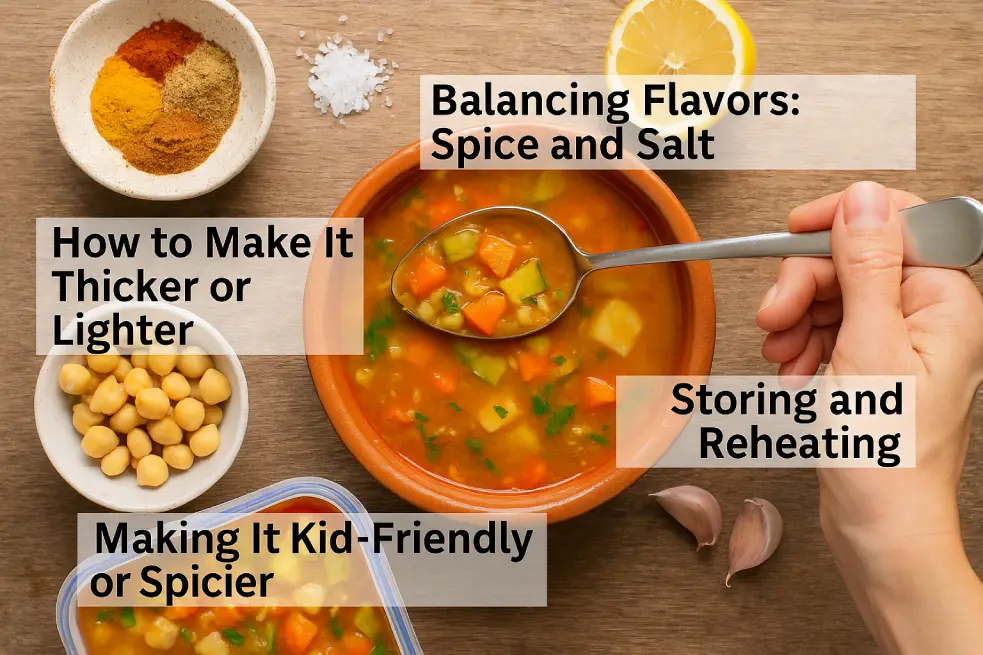
Everyone at the table can customize their bowl—one of the best things about Moroccan vegetable soup is its flexibility.
❓ Frequently Asked Questions (FAQ)
Here are some of the people’s most common questions about Moroccan vegetable soup. Whether making it for the first time or looking to adapt it for specific needs, you’ll find answers and tips here.
🌱 Is Moroccan vegetable soup vegan or vegetarian?
Traditionally, Moroccan vegetable soup contains only plant-based ingredients, making it suitable for vegan and vegetarian diets. It uses plant-based ingredients like carrots, zucchini, potatoes, tomatoes, and spices without animal products. If you’re sticking to a fully vegan recipe, use vegetable broth instead of chicken stock.
This makes it a perfect choice for those following a plant-based or Mediterranean diet, praised for its focus on whole, nutrient-dense foods.
❄️ Can I freeze this soup?
Absolutely. Moroccan vegetable soup freezes very well; some say it tastes even better after the flavors have rested. Allow the soup to cool thoroughly, then portion it into airtight containers for freezing.
✅ Label each portion with the date, and consume within 2–3 months for best quality.
When reheating, warm it gently on the stove and add a splash of broth or water if it has thickened too much. For more ideas on freezing and storing North African dishes, explore our stuffed leg of lamb recipe — another meal that holds up well in the freezer.
🥣 What’s the difference between this and lentil soup?
While both are hearty and full of vegetables, Moroccan vegetable soup has a broader flavor profile due to its use of ras el hanout, cumin, turmeric, and other warming spices. Lentil soup, in contrast, focuses more heavily on legumes and often uses fewer vegetables or spices.
The texture also varies — Moroccan soup can be chunky or smooth, while lentil soup tends to be thicker and more uniform. Both are nutritious, but the Moroccan version leans toward a spice-rich, layered experience.
🍗 Can I add meat or chicken?
Yes, although traditionally meatless, many Moroccan families add a small portion of shredded chicken or lamb pieces to make it more filling. If using meat, brown it first with onions and spices to help it infuse flavor into the base.
Adding meat transforms the soup into a comforting, tagine-inspired meal — ideal for chilly evenings or when you need more filling in a single pot.
🕌 Is it suitable for Ramadan or cold weather?
Moroccan vegetable soup is a go-to during Ramadan thanks to its lightness, nutrition, and comforting spices. It’s often served alongside dates and bread to break the fast gently.
In winter, its warming qualities — from the cumin and turmeric to the hearty root vegetables — make it a deeply satisfying choice. It’s also easy to digest, ideal during fasting or recovery.
🧂 What’s a good substitute for ras el hanout?
If you don’t have ras el hanout on hand, don’t worry — you can create a simplified version using what you have in your pantry. Mix:
- ½ tsp cumin
- ¼ tsp paprika
- ¼ tsp cinnamon
- Pinch of coriander and nutmeg
This quick blend won’t fully replicate the complexity of authentic ras el hanout, but it will still bring a Moroccan essence to your dish. For more details on the spice itself, this guide from MasterClass breaks down its origins and uses beautifully.
⏱️ How long does it take to cook?
Moroccan vegetable soup typically takes 45 to 60 minutes from prep to plate.
- Prep time: 15–20 minutes
- Simmering: 30–40 minutes
If you’re using dry legumes like lentils or chickpeas, pre-soak or pre-cook them to save time. This dish rewards patience, allowing flavors to deepen as it simmers.
🌀 Can I use a slow cooker?
Yes, and it works beautifully. After sautéing your spices, onions, and garlic on the stove, transfer everything to a slow cooker. Add the vegetables and broth, then set it to:
- Low for 6–7 hours
- High for 3–4 hours
This is an excellent option for busy days—you’ll come home to a kitchen filled with rich, comforting aromas. If you enjoy slow-cooked Moroccan recipes, our beef and fava bean tagine also works well in a similar setup.
📝 Conclusion
Moroccan vegetable soup is more than a recipe — a warm invitation to slow down, cook with intention, and connect with centuries of North African culinary wisdom. From its vibrant mix of seasonal vegetables to its soul-soothing blend of spices like cumin, turmeric, and ginger, this dish combines nourishment, flavor, and tradition in one humble pot.
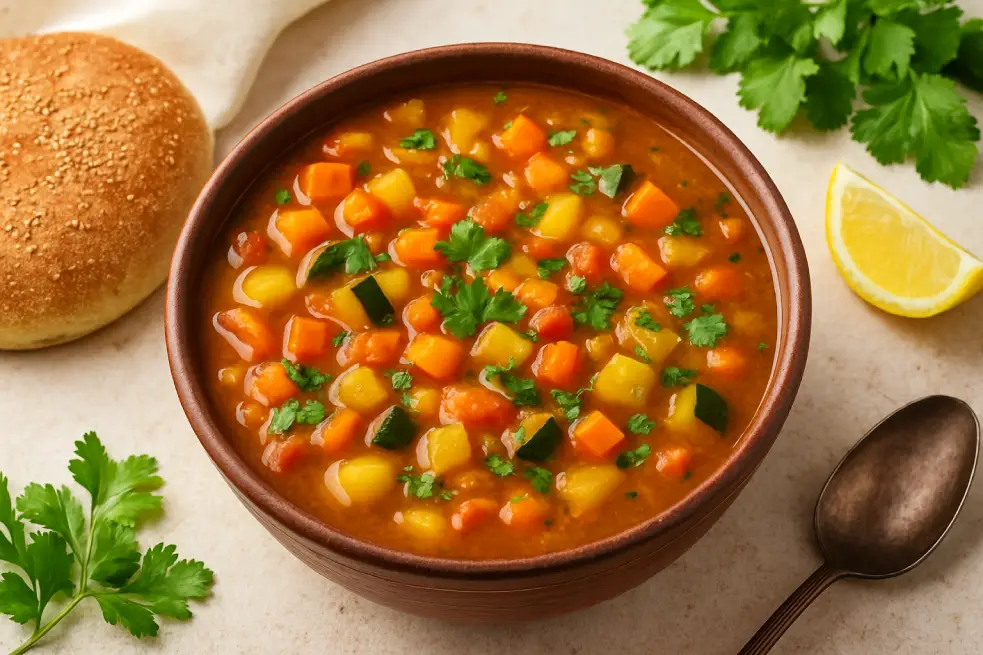
Whether you enjoyed it as a light, plant-based meal or added your twist with lentils or shredded chicken, this soup adapts beautifully to your table, any season, any occasion. It’s perfect for family dinners, quiet solo meals, or a larger Moroccan spread with mint tea, bread, and mezze-style sides.
If this recipe inspired you, here’s what you can do next:
- 🍴 Give it a go and feel free to personalize it — play with the spices or swap in your favorite vegetables to make it yours.
- 📌 Pin this recipe to your favorite board so it’s ready when you’re in the mood for a warm, comforting meal.
- 💬 Leave a comment below to let us know how it turned out, or share your twist.
- 📨 Send it to a friend who loves comforting, healthy recipes rooted in culture.
We hope this dish brings as much comfort to your kitchen as it has to countless Moroccan homes for generations. Bon appétit — or as we say in Morocco, B’saha!
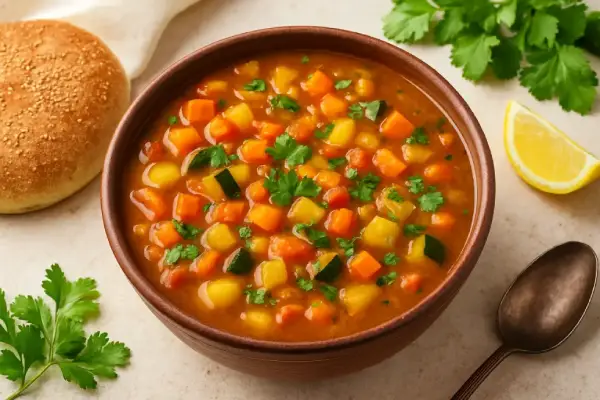
How to Make Moroccan Vegetable Soup (Simple + Delicious)
Ingredients
🧂 Ingredients:
- 2 tablespoons olive oil
- 1 yellow onion chopped
- 2 carrots grated or finely chopped
- 2 medium potatoes diced
- 1 zucchini cubed
- 2 ripe tomatoes diced (or 1 tbsp tomato paste)
- 2 cloves garlic minced
- ½ tsp ground cumin
- ½ tsp turmeric
- ½ tsp sweet paprika
- ¼ tsp ground ginger
- ½ tsp salt adjust to taste
- 1.2 liters 5 cups vegetable broth or hot water
- ½ cup cooked chickpeas or red lentils
- Fresh cilantro and parsley chopped
- Juice of ½ lemon
Instructions
🍲 Instructions:
- In a large pot, heat the olive oil over medium heat.
- Add the chopped onion and garlic. Sauté for 5 minutes until fragrant.
- Stir in cumin, turmeric, paprika, and ginger. Let spices bloom for 1–2 minutes.
- Add carrots, potatoes, zucchini, tomatoes, and chickpeas. Stir to coat with spices.
- Pour in vegetable broth. Bring to a boil, then reduce heat and simmer covered for 35–40 minutes.
- Taste and adjust salt if needed.
- Stir in chopped herbs and lemon juice just before serving.
- Serve hot with Moroccan khobz or crusty bread.
Notes
- For a thicker soup, mash some of the vegetables with a spoon or blend part of the soup.
- Add a pinch of cinnamon or harissa to adjust sweetness or heat.
- Soup can be refrigerated for 3–4 days or frozen for up to 3 months.
- Garnish with extra herbs or chili flakes for extra flavor.
🍽️ Nutrition Facts – Moroccan Vegetable Soup (per serving)
| Nutrient | Amount |
|---|---|
| Calories | ~180 kcal |
| Protein | ~6 g |
| Total Fat | ~7 g |
| – Saturated Fat | ~1 g |
| Carbohydrates | ~24 g |
| – Sugars | ~6 g |
| – Fiber | ~6 g |
| Sodium | ~520 mg* |
| Potassium | ~550 mg |
| Vitamin A | ~90% DV |
| Vitamin C | ~25% DV |
| Iron | ~10% DV |
| Calcium | ~6% DV |
📝 DV = Daily Value. Sodium content may vary depending on broth used.
📲 Let’s Stay Connected!
Loved this Moroccan vegetable soup recipe? Don’t forget to follow me on social media for more delicious, comforting meals from North Africa and beyond. I share exclusive kitchen tips, behind-the-scenes cooking moments, and fresh new recipes every week. Join our growing community of food lovers — I’d love to see your version of this soup, so feel free to tag me!
👉 Follow & tag your creations:
#MoroccanVegetableSoup #TajineRecipes #HealthyMoroccanFood #NorthAfricanCuisine #SoupSeason #PlantBasedMorocco #EasyMoroccanRecipes
✉️ Don’t Miss a Recipe – Join the Newsletter!
Get the taste of Morocco delivered straight to your inbox! Subscribe to my newsletter and receive weekly recipes, cooking tips, and exclusive content you won’t find on the blog. Whether you’re a fan of traditional tagines, fresh salads, or comforting soups like this Moroccan vegetable soup — there’s something flavorful waiting for you.
No spam, just authentic food inspiration.
👉 Sign up now and start cooking with heart!
📩 Join Our Moroccan Foodie Community
Get the best Moroccan tagine recipes and seasonal culinary tips straight to your inbox.
💬 What Did You Think?
Tried this Moroccan vegetable soup recipe? I’d love to hear how it turned out for you! Share your thoughts, ask a question, or tell me how you personalized the dish in the comments below. Your feedback helps others and keeps the kitchen conversation going. Let’s cook and grow together! 🫶
